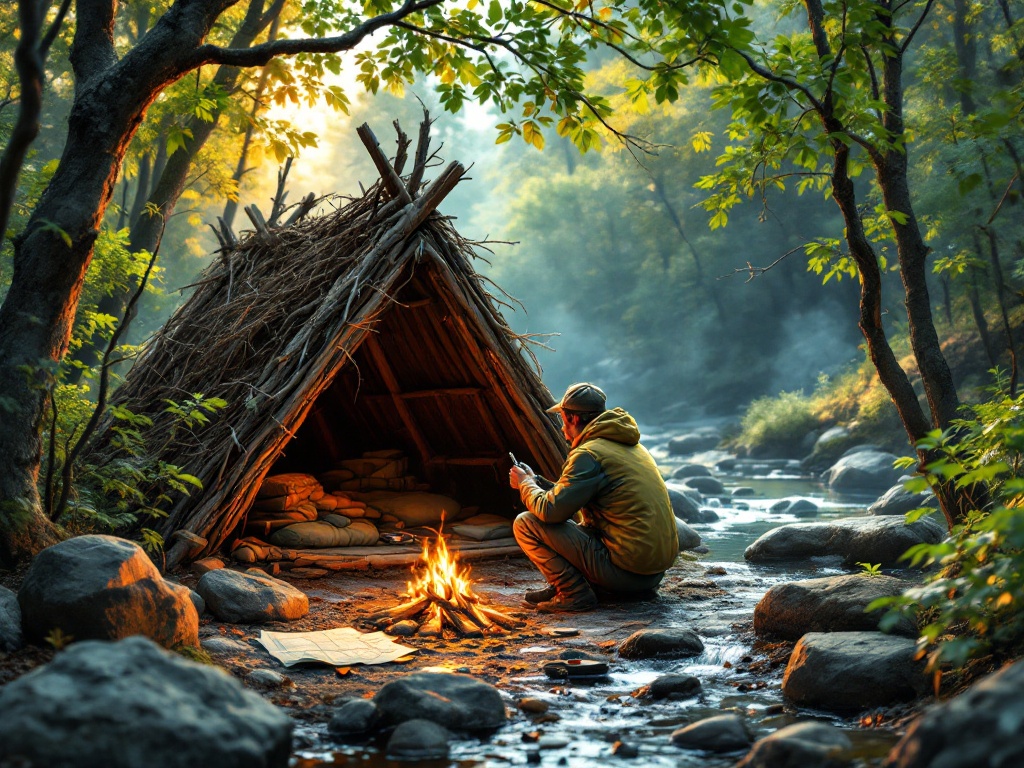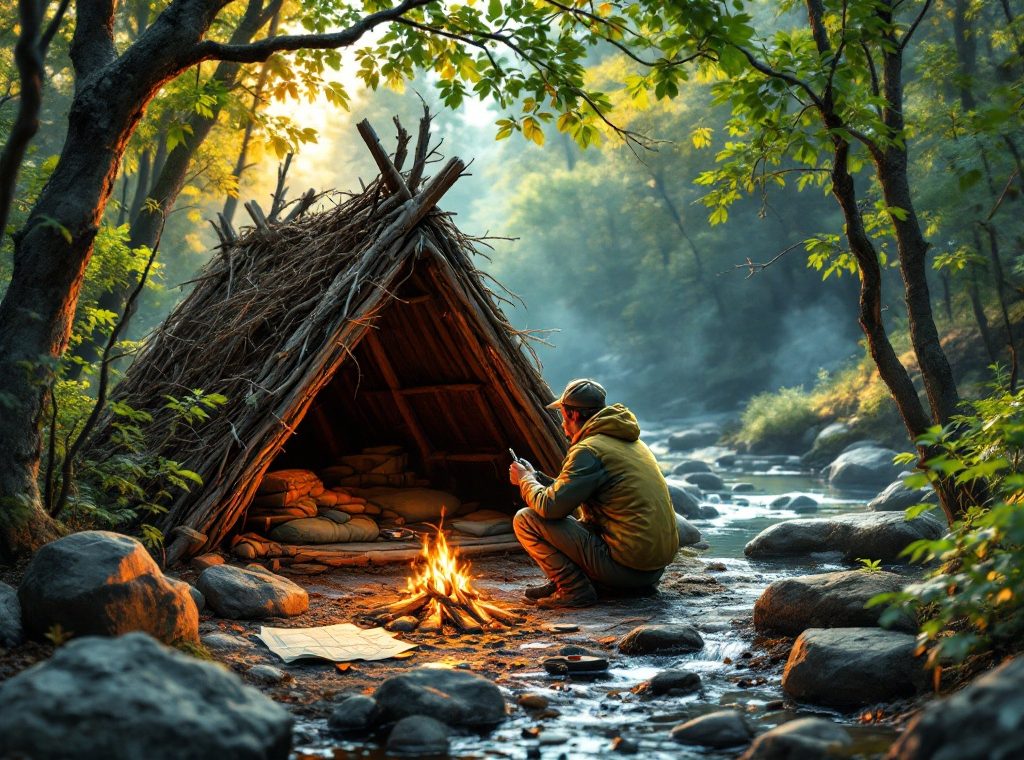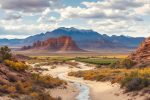The Ultimate Guide to Camping Survival: Essential Skills for Beginners
Venture into the wilderness with confidence! Learn essential camping survival skills to handle any unexpected situation. Discover how to build shelter, make fire, find safe water, and navigate with a map and compass. Master these skills and become a self-reliant explorer. Read on to unlock the secrets of wilderness survival.
Important information

- The “Big Four” survival skills are: Shelter, Fire, Water, and Food. Prioritize shelter, fire, and water before foraging for food.
- Shelter: Protects from the elements. Build a lean-to, A-frame, or debris hut using natural materials.
- Fire: Essential for warmth, cooking, purifying water, and signaling. Learn different fire-starting methods and practice in various conditions.
- Water: Safe drinking water is crucial. Purify water by boiling, filtering, or using purification tablets. Carry backup purification methods.
- First Aid: Pack a well-stocked first aid kit and learn basic first aid and CPR. Be prepared for common injuries and emergencies like hypothermia.
Understanding the Importance of Camping Survival Skills for Beginners
Essential camping survival skills empower beginners to confidently explore the wilderness. These skills act as a safety net, preparing you for unforeseen circumstances. Mastering these skills can significantly enhance your wilderness experience. Some of the most important skills include: building shelter for protection from harsh weather, making fire for warmth, cooking, and signaling, and finding and purifying water for safe hydration. Navigation skills are crucial for staying on course and finding your way back if lost. First aid knowledge allows for effective injury treatment.
Start Learning Essential Survival Skills
Shelter
Building a proper shelter protects you from harsh weather conditions like rain, wind, and sun. It provides a safe and stable environment, crucial for survival.
Fire
Fire is essential for warmth, cooking food, purifying water, and signaling for help. It’s a multifunctional tool that significantly increases your chances of survival.
Water
Locating and purifying safe drinking water is paramount for staying hydrated and healthy in the wilderness. Dehydration can quickly become a serious threat, so securing a reliable water source is a top priority.
Food
While food is important for sustenance, securing shelter, fire, and water are often more immediately vital. Once these are established, foraging for food becomes the next priority.
Researching the Big Four: Shelter, Fire, Water, and Food
Survival in the wilderness depends on mastering a few essential skills. Building shelter is crucial; learn to construct a lean-to or a debris hut for protection from the elements. Fire is equally important, providing warmth, a way to purify water, and a signal for rescue; mastering techniques like the hand drill or fire plow can be life-saving. Finding a source of safe drinking water is also vital for staying hydrated and healthy, which can be achieved through boiling, water purification tablets, or a filtration system. Securing food requires knowledge of edible plants in the area and trapping skills. Honing these skills can ensure safety and survival in the wild.
Build a shelter. Constructing a lean-to or debris hut can provide crucial protection from the elements.
Make fire. Fire provides warmth, a way to purify water, and a signal for rescue. Mastering techniques like the hand drill or fire plow can be life-saving.
Find safe drinking water. Staying hydrated is essential for survival. Boiling, purification tablets, or a filtration system can make water safe to drink.
Secure food. Learn about edible plants in the region and practice trapping skills to ensure a source of nourishment.
Practice Makes Perfect: Get Out and Practice Survival Skills
Honing survival skills is essential for developing self-reliance and resourcefulness. Consistent practice builds confidence and prepares you for unexpected situations. It strengthens vital abilities such as: constructing shelter, igniting fires, purifying water, and foraging for food. Vary your training grounds and weather conditions to improve decision-making under pressure. Challenge yourself to build a shelter in the rain, but prioritize safety. Training with others encourages teamwork and accelerates learning.
Constructing shelter: Learn different shelter-building techniques using available materials.
Igniting fires: Practice various fire-starting methods in diverse conditions.
Purifying water: Master techniques for making water safe to drink in the wilderness.
Foraging for food: Learn to identify edible plants and acquire safe food-gathering skills.
Vary training locations and conditions: This improves adaptability and decision-making skills under pressure.
Prioritize safety: While pushing your limits, always ensure your safety during training exercises.
Group training fosters teamwork and accelerates learning. Regular practice significantly enhances preparedness, ultimately transforming you into a more resourceful and self-reliant individual.
Building a Shelter: Types and Techniques
Building a Quick Lean-To
A quick lean-to can be constructed by simply propping branches against a tree.
Constructing an A-Frame Shelter
For enhanced protection, an A-frame uses two angled poles draped with a tarp or foliage.
Creating a Debris Hut
Even greater insulation is offered by a debris hut, formed by layering leaves and branches over a frame.
Using Tents and Tarps
Tents and tarps provide lightweight, portable alternatives.
Choosing a Safe Campsite
- When selecting a site, prioritize safety.
- Avoid hazards such as dead trees and flood-prone areas.
Preparation and Practice
- Boost your confidence by practicing different shelter designs before your trip.
- Exploring traditional shelters, like Native American wickiups and hogans, can offer valuable insights into clever building techniques.
Constructing Emergency Shelters for Wilderness Survival
Building a quick shelter is crucial for wilderness survival, protecting you from rain, wind, and extreme temperatures. Utilize natural materials like branches, leaves, and pine boughs, and a tarp if available. Common shelter designs include:
- Lean-to: Lean branches against a tree or rock to form a slanted roof.
- A-frame: Use two slanted poles covered with branches or a tarp for increased protection.
- Debris hut: Offers superior insulation by piling leaves and pine needles over a frame.
Prioritize safety when building any shelter. Choose a secure location away from falling branches, dead trees, and flood-prone areas. A dry spot slightly uphill is ideal. Ensure the shelter is large enough to lie down in comfortably.
Mastering Fire Making Techniques
Building a fire is essential for wilderness survival, providing warmth, cooking capabilities, and light. Three key components are needed: tinder, kindling, and fuelwood. Tinder, such as dry leaves, birch bark, or pine needles, ignites quickly from a spark. Kindling, consisting of small dry twigs and branches, catches fire from the tinder and builds the flames. Lastly, larger pieces of fuelwood sustain the fire’s strength.Several methods can start a fire, including matches, lighters, ferrocerium rods, or friction-based methods like a bow drill. Build the fire in a structure that allows airflow, such as a teepee or log cabin shape. Prioritize safety by selecting a location away from flammable materials and keeping water or sand nearby for extinguishing.
Find dry tinder even in wet weather. Look inside dead trees or under rocks.
Create a platform. Use dry sticks or rocks to elevate your tinder and kindling above damp ground.
Shield the flames. Protect the nascent flames from the wind.
Build a windbreak in windy conditions by using rocks or logs. Start small and gradually build the fire with a fire starter or fine kindling.
Always follow Leave No Trace principles. Use existing fire rings or build fires on durable surfaces like rock or sand. Ensure the fire is completely extinguished before leaving.
Starting a Fire in Various Conditions
Igniting a fire in damp conditions requires resourcefulness. Seek out the driest tinder available, such as birch bark or a bird’s nest. A fire starter or feather stick will ensure a quick catch. In windy conditions, construct a fire pit using rocks to shield the nascent flames. Begin with small kindling, gradually adding larger fuel as the fire intensifies. At higher altitudes, the reduced oxygen necessitates smaller pieces of wood and a tighter construction to concentrate the heat.
Find dry tinder. Look for birch bark, a bird’s nest, or other dry materials to start your fire.
Use a fire starter. A fire starter or feather stick will help ignite the tinder quickly.
Build a windbreak. If it’s windy, use rocks to create a fire pit and protect the flames.
Start small and gradually increase fuel size. Begin with small kindling and add larger pieces of fuel as the fire grows stronger.
Adapt to high altitudes. At higher altitudes, use smaller pieces of wood and a tighter construction to compensate for reduced oxygen.
Water Purification and Safety
Safe drinking water is essential in the wilderness. Here’s how you can ensure a safe water supply:
Boiling: boil water vigorously for one minute to eliminate most harmful bacteria and viruses.
Filtering: use a water filter to remove contaminants such as sediment and protozoa.
Chemical purification: use chemical purification tablets, but be aware they might leave an aftertaste.
The best choice depends on your available resources and the specific water source. Avoid stagnant water as it tends to harbor more contaminants. Flowing sources, like streams or rivers, are generally safer, but purification remains crucial. Even clear streams can contain harmful microorganisms. Consider packing backup purification methods to ensure a safe water supply in any situation.
Learning How to Purify Water in Different Scenarios
Boiling water for a minute eliminates most harmful bacteria, making it safe to drink.
Water purification tablets use chemicals to treat water.
Portable filters remove bacteria and protozoa.
UV purifiers use ultraviolet light to kill pathogens, but they may be less practical in the wilderness, often needing batteries or sunlight.
These methods provide access to safe drinking water in the backcountry, keeping you hydrated and healthy on your adventures.
Foraging and Food Sourcing in the Wild
Foraging for wild edibles like plants, berries, nuts, and mushrooms can be a rewarding experience. Use a reliable guidebook or app to safely identify these treasures. If you’re unsure about a plant, do not eat it. Responsible foraging means taking only what you need and preserving our natural resources. Trapping small game with snares and deadfalls offers another way to find sustenance. Learn how to build and set these traps safely and ethically, always following local regulations.
Understanding Food Foraging and Traps
Food Foraging
Food foraging involves searching for edible plants, such as dandelions, clover, and wild berries, as well as nuts, such as acorns. Accurate plant identification is essential for safe foraging. Consult reliable resources for guidance on safe foraging practices.
Trapping
Trapping focuses on capturing animals for sustenance by constructing traps. Understanding local fauna and effective trapping methods are crucial for successful trapping. Consult reliable resources for guidance on trapping practices.
Navigating the Wilderness: Essential Skills
Wilderness navigation relies on essential skills, most importantly map and compass reading. A compass indicates direction, while a map displays the terrain. Orienteering combines these tools to pinpoint your location and plan routes.
Traditional Navigation
When a map and compass are unavailable, natural navigation becomes crucial. Observe the sun, stars, and land formations; these natural cues can guide you.
Modern Technology vs. Basic Skills
While GPS devices offer helpful digital navigation, basic map and compass skills remain vital. Technology can malfunction, so practicing these skills is essential. Start in familiar areas, then gradually explore more challenging wilderness terrain.
Using Map and Compass for Navigation
Orient your map to the surrounding terrain.
Point the compass’s direction of travel arrow along your planned route.
Rotate the compass housing until the magnetic needle aligns with the orienting arrow.
Follow the direction of travel arrow, but regularly check your progress and adjust your course as needed to stay on track.
First Aid and Emergency Preparedness
A well-stocked first aid kit is essential for any camping trip. It enables you to treat common injuries such as cuts, burns, insect bites, and allergic reactions. Pack antiseptics, bandages, pain relievers, and wound care tools. Having a kit isn’t enough; you also need basic first aid knowledge. Understanding CPR, recognizing hypothermia and heat exhaustion, and familiarizing yourself with basic anatomy and common wilderness injuries can be crucial in an emergency.
Building a Basic First Aid Kit
A well-stocked first aid kit is indispensable for any outdoor adventure or emergency situation. Be sure to include these essential items: antiseptic wipes for cleaning cuts and scrapes, assorted bandages for covering wounds, gauze pads for larger injuries, and medical tape to secure dressings. Pain relievers such as ibuprofen or acetaminophen can help manage discomfort, while antihistamines are crucial for allergic reactions. Don’t forget essential tools like tweezers for removing splinters and scissors for cutting bandages or clothing. A comprehensive first aid manual can provide valuable guidance in various situations. For hikers, blister treatment is a must-have to prevent further discomfort on the trail. Finally, insect repellent and sunscreen offer crucial protection against sunburn and pesky bugs, ensuring a safe and enjoyable outdoor experience.
Campsite Safety and Survival Gear
Pack a first aid kit containing antiseptics, bandages, and pain relievers.
Include fire-starting tools, like waterproof matches or a lighter.
For navigation, bring a map and compass.
Pack a multi-tool or knife for various tasks.
Include signaling devices, such as a whistle, for emergencies.
Pack water purification tablets or a filter for clean drinking water.
Bring emergency food rations.
Don’t forget a flashlight and extra batteries.
Pack a durable tarp or emergency blanket for shelter.
Remember personal medications and identification.
Consider a portable phone charger.
Bring rope or paracord, which can be incredibly handy.
Essential Safety Gear and Survival Kit Supplies
Pack a first-aid kit with a comprehensive manual.
Include a map and compass for navigation.
Bring a bright flashlight or headlamp with extra batteries.
Pack a whistle, multi-tool, and fire-starting tools (waterproof matches, a lighter, or a dedicated fire starter).
Include a signaling device, such as a mirror.
Pack water purification tablets or a filter, along with emergency food rations like energy bars or dehydrated meals.
For shelter, bring a tarp, emergency blanket, or bivy sack.
Pack extra clothing for warmth in unexpected conditions.
Signaling and Knot Tying for Emergencies
Effective rescue relies heavily on signaling. Tools like mirrors and whistles can be lifesavers. Bright, vivid clothing also increases visibility.
Knot-tying skills are crucial for building shelters, crafting traps, and securing equipment. Essential knots to master include the bowline, square knot, and clove hitch. These skills could prove invaluable in a survival situation.
Effective Signaling Techniques
Use a signal mirror. Flashing sunlight across miles with a signal mirror can help rescuers locate you from afar.
Use a whistle. A whistle is invaluable for shorter distances, helping attract attention.
Wear bright clothing. Bright clothing increases your visibility, making it easier for rescuers to spot you.
Create ground-to-air signals. If an aircraft is nearby, use rocks or branches to create these signals in a large, open space.
By using these techniques, you’ll significantly improve your rescue prospects. Stay safe and be prepared.
Practicing Leave No Trace Principles
Minimize campfire impact by using established fire rings or a camp stove.
Keep campsites small, avoiding plant disturbance.
Pack out all trash, including food scraps and litter.
Leave natural and cultural artifacts undisturbed.
Respect wildlife and their habitats.
Travel and camp on durable surfaces like trails and designated campsites.
Dispose of waste properly, leaving nature pristine for others to enjoy.
Respecting Wildlife and Preserving Nature
Respect wildlife by observing them from a distance. This ensures both your safety and theirs.
Avoid feeding wild animals. This disrupts their natural foraging habits and creates dependence on humans.
Pack out everything you pack in, leaving no trace behind.
Stay on marked trails to minimize your impact on the environment.
Respect animal habitats by avoiding nests, dens, and other homes.
Keep quiet to avoid startling wildlife and disrupting the natural soundscape.
Properly dispose of human waste to prevent water contamination and disease.
Be mindful of campfire regulations and practice fire safety to prevent wildfires.













